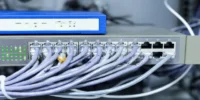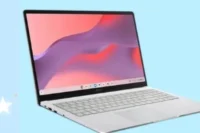Best DTF Printer Guide: Easy Choice for Beginners
Published: 18 Mar 2025
DTF Printer
If you’re new to custom printing and wondering what a DTF printer is, you’re in the right place. A DTF (Direct to Film) printer is a popular machine that allows you to print designs on a special film and then transfer them onto fabric using heat. It’s becoming a favorite choice for small business owners and hobbyists because it works on many types of fabrics like cotton, polyester, and blends, without needing any pre-treatment. In this guide, we’ll explore how DTF printers work, why they’re so useful, and how you can get started easily.
What is a DTF Printer?
A DTF printer (Direct-to-Film Printer) is a machine that prints designs onto special film, which is then transferred to fabric using heat. It works on all types of fabrics and creates long-lasting, vibrant prints.
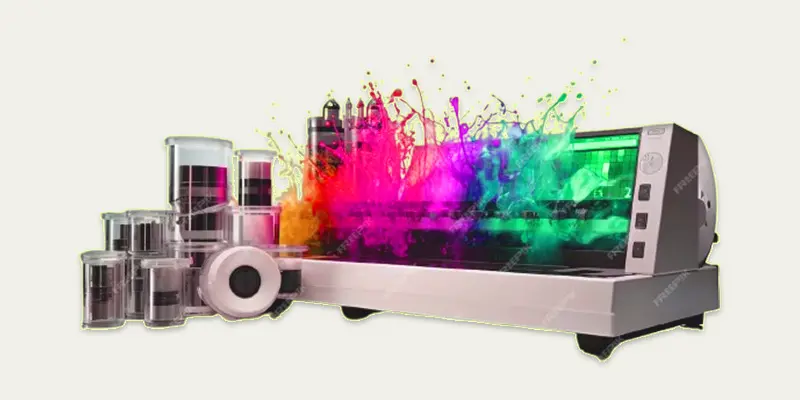
How Does a DTF Printer Work?
For a long-lasting print, a DTF printer prints a design on a special film, applies adhesive powder, cures it, and then heat presses it into cloth.
- Design Creation
- Printing on PET Film
- Applying Adhesive Powder
- Curing the Powder
- Heat Press Transfer
- Final Print on Fabric
Design Creation
Design creation is the first step in DTF printing. You create your artwork using design software like Photoshop or CorelDRAW. The design is then prepared for printing with the right colours and settings.
Printing on PET Film
In this process, coloured and white ink are used by the DTF printer to print the design onto a special PET film. On dark textiles, the white ink layer makes the design pop out. For optimal results, the print needs to be clear and aligned correctly.
Applying Adhesive Powder
After printing, a special adhesive powder is sprinkled over the wet ink on the PET film. This powder sticks to the ink and helps the design bond with the fabric. Any extra powder is removed to keep the print clean.
Curing the Powder
The adhesive powder needs to be heated to cure it. This is done using a heat press or an oven at the right temperature. Curing helps the powder melt and stick properly, making the design ready for transfer.
Heat Press Transfer
The PET film with the cured design is placed on the fabric, then pressed with a heat press at a high temperature. This melts the adhesive, making the design stick to the fabric. After pressing, the film is peeled off, leaving a vibrant print.
Final Print on Fabric
Once the film is peeled off, the design stays on the fabric with a smooth and durable finish. The print is vibrant, stretchable, and long-lasting. A final press may be done to improve durability and feel.
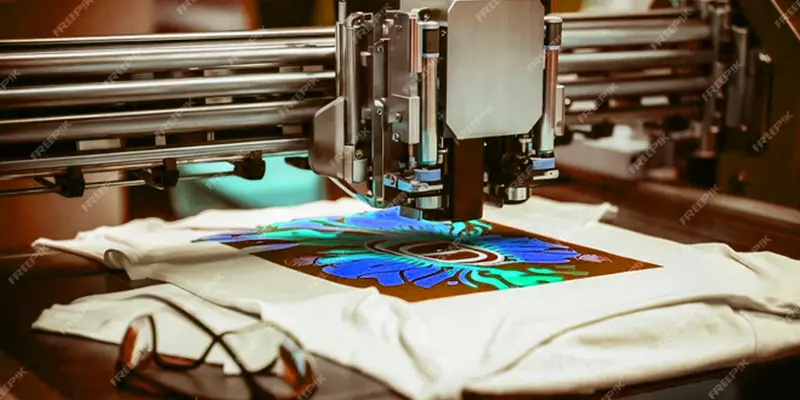
Top 5 Advantages of Using a DTF Printer
A DTF printer offers several benefits that make it a great choice for custom printing. It’s easy to use, versatile, and perfect for both beginners and small businesses.
- Works on all types of fabrics, including cotton and polyester.
- No pre-treatment needed before printing.
- Produces vibrant, long-lasting prints.
- Great for small or large production runs.
- Cost-effective setup with high-quality results.
Top 5 Disadvantages of Using a DTF Printer
While DTF printers offer many advantages, they also come with a few downsides that beginners should be aware of before getting started.
- Requires regular maintenance to avoid ink clogging.
- Special DTF inks and films can be costly.
- Print quality depends heavily on proper temperature and pressure.
- Some printers may need modifications or extra software.
- Excess adhesive powder can create a mess if not handled carefully.
Why DTF Printers Are So Popular for Quality & Versatility?
DTF printers are versatile because they can print on cotton, polyester, leather, and more without needing fabric pre-treatment. They produce vibrant, long-lasting prints with excellent color accuracy. Their ability to handle detailed designs and various materials makes them ideal for customization.
These printers use high-quality ink and adhesive powders to ensure strong adhesion and durability. The soft feel and stretchability of prints make them perfect for fashion and merchandise. With low maintenance and cost-effective printing, DTF technology is a game-changer for businesses.
DTF Printer vs Other Printing Methods: Which One Is Best?
When choosing the right printing method, it’s important to understand how a DTF printer compares to other popular options like DTG, sublimation, and screen printing. Each method has its own strengths and best uses.
DTF
DTF (Direct-to-Film) printing is a modern technique that offers vibrant colours and durability, making it a great choice for fabric printing. Unlike traditional methods, it works on various materials without requiring expensive pre-treatment.
Screen Printing
Screen printing is a classic method that provides high-quality prints but requires a lot of setup, making it more suitable for bulk orders rather than small runs.
DTG
DTG (Direct-to-Garment) printing offers detailed prints on cotton fabrics but struggles with synthetic materials and lacks the durability of DTF.
Sublimation Printing
Sublimation printing is another option, but it only works on polyester or specially coated surfaces, limiting its use.
Heat Transfer Vinyl (HTV)
Heat transfer vinyl is a manual process that applies cut-out designs using heat, but it lacks the flexibility and fine detail of DTF.
Laser and Inkjet Heat Transfers
Laser and inkjet heat transfers allow for easy customization but often result in prints that fade or crack over time. Compared to these methods, DTF printing stands out because of its ability to print on various fabrics, its durability, and its cost-effectiveness for both small and large orders.
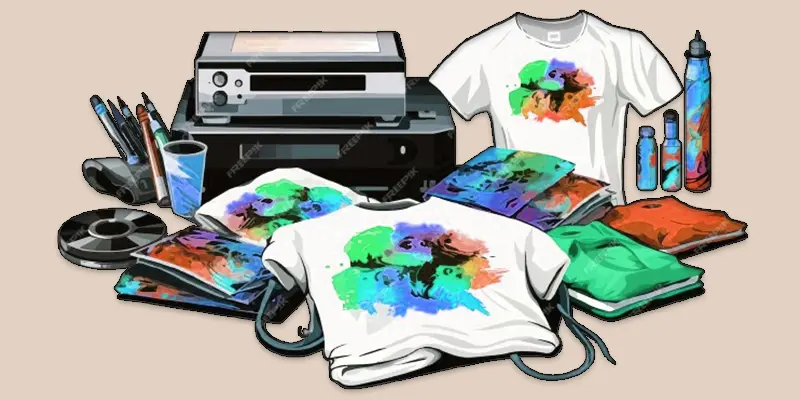
Buying a DTF Printer? Here’s What You Must Consider
Before investing in a DTF printer, it’s important to know what features and factors matter most. This helps you choose the right machine for your needs and budget.
5 Key Things to Watch When Choosing the Right DTF Printer
- Printing Size: Choose a printer that fits your typical design dimensions, whether for small logos or full-shirt prints.
- Print Quality: Look for printers that deliver sharp, vibrant, and durable prints without fading or cracking.
- Ease of Use: Beginners should go for user-friendly models with simple setup and operation.
- Maintenance Requirements: Select a printer that’s easy to clean and maintain, reducing downtime and costs.
- Budget & Support: Balance your budget with features, and always check if the brand offers good customer support and warranty.
Best DTF Printer Brands to Check Out This Year
If you’re planning to start DTF printing, choosing a trusted brand can make a big difference in quality and performance. Here are some of the top DTF printer brands people are using this year:
Epson L1800 (Converted for DTF)
- Popular among beginners for its affordability and print quality.
Procolored DTF Printers
- Known for compact designs, fast printing, and user-friendly features.
Prestige A3+ DTF Printer
- A great mid-range option with consistent results and support.
STS Mutoh DTF Printer
- High-end, industrial-grade printer for professional use and bulk printing.
Punehod DTF Printer
- Budget-friendly choice with decent performance for small businesses.
Common DTF Printer Problems Beginners Often Face
When starting out with a DTF printer, beginners may run into a few problems that can affect print quality and workflow. Knowing these early on can save time and frustration.
- Ink Clogging: Ink can dry in the nozzles if the printer isn’t used regularly.
- Poor Film Transfer: The design may not stick well if heat or pressure is incorrect.
- Dull Colors: Low-quality ink or wrong settings can cause faded or washed-out prints.
- Peeling After Wash: Improper curing can lead to the print cracking or peeling off.
- Messy Powder Handling: Adhesive powder can spill easily and create a cluttered workspace.
10 Helpful Tips for Smooth and Easy DTF Printing
To get the best results from your DTF printer, it’s important to follow a few simple practices that can help avoid mistakes and improve print quality.
- Print regularly to prevent ink from drying and clogging the nozzles.
- Use high-quality DTF ink for vibrant and long-lasting results.
- Always shake the adhesive powder evenly over the film.
- Set the correct heat press temperature for proper film transfer.
- Use the right pressure and timing during heat pressing for better adhesion.
- Keep your workspace clean to avoid dust or powder affecting prints.
- Pre-check your design and film size before printing to avoid waste.
- Use RIP software properly to control print color and quality.
- Dry the film fully before heat pressing to prevent smudges or peeling.
- Follow fabric washing guidelines to keep the print looking fresh longer.
Final Thoughts
A DTF Printer is a game-changer for custom printing, offering vibrant colours and durable designs. If you’re looking for high-quality prints with versatility, I highly recommend investing in a reliable DTF printer. It’s perfect for businesses and hobbyists alike. Are you prepared to advance your printing? Examine the top DTF printers right now.
FAQS About DTF Printer: Quick Answers for Beginners
Yes! DTF printing produces vibrant, durable, and high-quality prints that work on various fabrics. It offers excellent colour accuracy and stretchability.
A DTG printer is worth it if you print on cotton-based fabrics and want high-detail designs. However, it’s costly and requires maintenance.
First, print the design on a special DTF film. Then, apply adhesive powder and heat it. Finally, press the design onto the fabric using a heat press.
Load the DTF film, print the design, add adhesive powder, cure it with heat, and press it onto fabric using a heat press.
DTF prints can last for years if properly applied and washed. They resist fading, cracking, and peeling better than many other printing methods.
Use a cleaning solution and a lint-free cloth to wipe the print-head. Run an automatic cleaning cycle regularly to prevent clogging.
DTG prints directly on fabric and works best on cotton, while DTF prints on film and transfers to fabric, working on various materials.
No, regular inkjet printers don’t support DTF ink and film. You need a modified inkjet printer designed for DTF printing.
No, sublimation printers use heat-activated ink, which won’t work for DTF printing. DTF requires special inks and transfer films.
Yes, DTF printers can print white ink, which helps designs stand out on dark fabrics.
Your printer may be offline due to connectivity issues, outdated drivers, or low power mode. Restart it and check the network settings.
DTF printing transfers designs from a special film to fabric using heat. It’s durable, colourful, and works on various materials.

- Be Respectful
- Stay Relevant
- Stay Positive
- True Feedback
- Encourage Discussion
- Avoid Spamming
- No Fake News
- Don't Copy-Paste
- No Personal Attacks



- Be Respectful
- Stay Relevant
- Stay Positive
- True Feedback
- Encourage Discussion
- Avoid Spamming
- No Fake News
- Don't Copy-Paste
- No Personal Attacks



